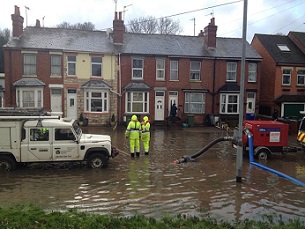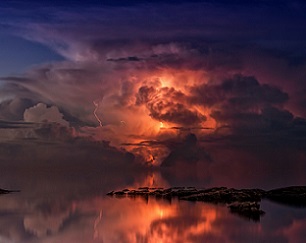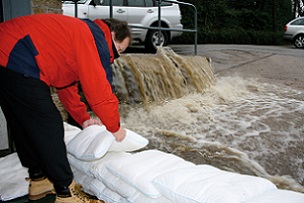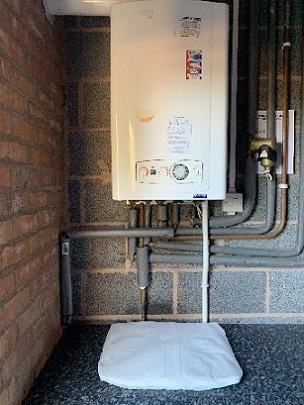 Flash floods can happen in minutes
Flash floods can happen in minutes
 Thunderstorms leading to flash floods can happen anywhere at any time
Thunderstorms leading to flash floods can happen anywhere at any time
 FloodSax alternative sandbags can hold back a torrent of floodwater
FloodSax alternative sandbags can hold back a torrent of floodwater
 FloodSax can also be used inside to soak up leaks, drips, spills and internal floods
FloodSax can also be used inside to soak up leaks, drips, spills and internal floods
 FloodSax are so easy to store and deploy
FloodSax are so easy to store and deploy
What causes flash flooding and why is it so dangerous?
The most dangerous floods of all are flash floods as they combine ferocious speed with a frightening destructive power.
In the last year alone we have seen terrible flash flooding hit London twice causing millions of pounds damage but it can happen anywhere and at any time and often does without being so widely publicised.
London hit the headlines because it happened on such a huge scale.
What causes flash flooding?
Flash flooding can come from torrential downpours or from severely overflowing rivers.
A sudden and incredibly powerful deluge of rain which people sometimes refer to as a cloudburst can drop thousands of tonnes of water on an area in just minutes and, basically, the ground it lands on simply can’t cope with that huge amount of water suddenly falling on it.
Flash flooding – which can often happen during thunderstorms - is often caused when ground is bone hard dry or, ironically, already saturated with rain. Also, many areas in cities and built-up areas have been concreted or paved over with gardens and grass vanishing replaced with driveways for car parking.
This is known as urban creep and is happening across the UK.
Add in the possibility that drains and gullies have not been cleared out by councils and you’ve a recipe for a massive flooding disaster. Flash floods often hit quite small areas so are impossible to predict but the consequences can be devastating.
Although officially defined as floods that can happen within six hours of heavy rain, flash floods usually happen within minutes of a torrential downpour giving people very little time to react to get flood defences in place to save them from the catastrophic consequences of flooding.
The Met Office states: “Flash flooding happens when rain falls so fast that the underlying ground cannot cope or drain it away fast enough. Roads can become like rivers and if there is a lot of water it can flood buildings and carry cars away. So, if the rain is falling too fast for the ground or drains to cope there is a risk of flash flooding.”
The Met Office also reveals how rivers can also cause flash flooding.
It states: “Most rivers flow fairly gently as they slope slowly towards the sea. Therefore, when a river floods it does so quite slowly as it takes time for the rain to percolate through the ground and into the rivers and out to sea − allowing time for some warning. But with flash flooding there is often very little time between the rain falling and flash flooding occurring.
“Flash flooding commonly happens more where rivers are narrow and steep so they flow more quickly. It can also occur away from small rivers in built-up urban areas where hard surfaces such as roads and concrete don’t let the water drain away into the ground. This leads to surface overflow and can often overwhelm local drainage systems leading to flash flooding.”
The worst example of river flash flooding in the UK in recent times happened in the village of Boscastle in Cornwall on August 16, 2004, when an exceptional amount of rain fell in just a couple of hours.
Very heavy rain – equivalent to a month - fell in storms close to the village, causing two rivers to burst their banks and around two billion litres of water then rushed down the valley straight into Boscastle.
Residents had little time to react. Cars were swept out to sea, buildings were badly damaged and people had to act quickly to survive. Fortunately, nobody died but the damage ran into millions of pounds.
Why is flash flooding so dangerous?
Flash flooding is dangerous mainly because it happens so quickly no-one has time to prepare flood defences unless they already have them in their homes or businesses and can deploy them immediately.
It means there is very little time to put out any effective warnings.
Flash floods are dangerous because only 6 inches of water is enough to knock a person off their feet. Just 12 inches is enough to move a car and if it goes above 18 inches then that’s powerful enough to sweep a larger vehicle away.
People underestimate the weight and power of water but if you just fill a bucket up and carry it then that’s heavy enough. Flash floods involve millions of gallons of water moving rapidly so the destructive power of a flash flood is immense.
The other danger is that flash floods are filled with debris and all kinds of hidden hazards being swept along beneath the water surface. You just don’t know what is being carried swiftly out of sight in the water such as branches and stones which could cause serious injury.
So, the simple advice is to get up to higher ground away from flash floods as quickly as possible and never try to drive through a flood as it could end up with you losing your vehicle or even worse, your life.
Everyone is responsible for their own flood protection at all times. Councils in the UK have no responsibility to provide sandbags and people need to organise protecting their own homes and businesses from flooding.
Some councils recommend FloodSax ‘sandless’ sandbags which are a flexible alternative to traditional sandbags that are space-saving to store and quick and easy to deploy.
They are vacuum-packed and when unwrapped resemble a large pillowcase but when FloodSax are immersed in water they absorb 20 litres which transforms them from being as light as a pillowcase to being more effective than traditional sandbags in around five minutes.
In their dry state they are super-absorbent yet thin with a large surface area so are highly effective at soaking up drips, leaks, spills and floods inside homes and businesses, especially in hard-to-reach places such as beneath pipes, radiators, sinks and boilers.
Almost 3 million have now been sold worldwide.